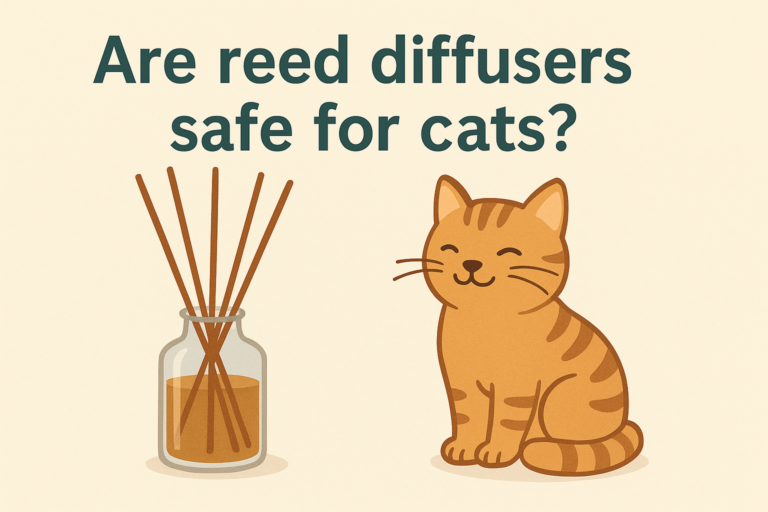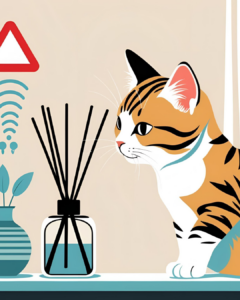🐾 Are Reed Diffusers Safe for Cats?
Reed diffusers are a popular choice for keeping homes smelling fresh and inviting. But if you’re a cat owner, you might be wondering: Are reed diffusers safe for cats? The short answer is not always.
Cats have a far more sensitive sense of smell than humans, and some of the ingredients in reed diffusers can pose serious risks. While not all reed diffusers are inherently toxic, many contain essential oils or solvents that can be harmful—even fatal—to cats. Understanding the potential risks and learning how to minimize them is essential for every responsible pet owner.
In this article, we’ll dive deep into what reed diffusers are, which ingredients are dangerous, what symptoms of toxicity to watch out for, and safer alternatives to help you maintain a pleasant-smelling home without jeopardizing your furry friend’s health.
Contents
- 1 🧪 Understanding Reed Diffusers
- 2 🧴 Common Ingredients in Reed Diffusers
- 3 👃 How Cats React to Scents
- 4 🌿 Are Essential Oils Safe for Cats?
- 5 🐱 Signs of Toxicity in Cats
- 6 🌸 Safer Alternatives to Reed Diffusers
- 7 👩⚕️ Expert Opinions and Vet Advice
- 8 🏡 How to Use Reed Diffusers Safely Around Cats
- 9 🧼 Natural DIY Diffuser Recipes
- 10 🧍♂️ Real Stories from Pet Owners
- 11 📚 Scientific Studies on Aromatherapy & Pets
- 12 ✅ Final Verdict: Are Reed Diffusers Worth the Risk?
- 13 ❓ FAQs
🧪 Understanding Reed Diffusers
Reed diffusers are a type of passive air freshener that works by allowing scented oils to travel up wooden reeds and disperse fragrance into the air. They’re simple, elegant, and require no heat or electricity.
Components of a reed diffuser typically include:
- A glass bottle or jar
- Fragrance oil (often essential oil-based)
- Wooden reeds (usually rattan)
The idea seems harmless, but problems arise from what’s inside the diffuser. Some of the oils used for scenting are completely safe—others, unfortunately, can be quite toxic to cats.
🧴 Common Ingredients in Reed Diffusers
Here’s where things get a little tricky. The majority of reed diffusers are made using essential oils combined with a carrier solvent like dipropylene glycol (DPG) or isopropyl alcohol.
Let’s break it down:
🚫 Harmful Ingredients for Cats
| Ingredient | Risk |
|---|---|
| Tea Tree Oil | Neurotoxic, even in small doses |
| Eucalyptus | Can cause drooling, vomiting, tremors |
| Peppermint | Irritating to airways and liver-toxic |
| Citrus Oils (Lemon, Orange, Bergamot) | Cause GI upset, liver toxicity |
| Pine Oils | Linked to liver damage and breathing issues |
| Cinnamon | Toxic if ingested or inhaled |
| Alcohol-based Carriers | Can cause respiratory irritation |
✅ Safer Ingredients (with Caution)
| Ingredient | Note |
|---|---|
| Lavender (low concentrations) | Still controversial—some experts advise caution |
| Chamomile | Generally soothing but can cause allergies |
| Cedarwood | Safer when heavily diluted |
| Frankincense | Mildly irritating but low-risk in minimal use |
👃 How Cats React to Scents
Cats have over 200 million scent receptors—far more than humans. This means that even a faint whiff of something to us could be overwhelming, or even painful, to a cat.
Also, unlike dogs and humans, cats lack certain liver enzymes (like glucuronyl transferase) that help break down toxins. This makes it difficult for cats to metabolize essential oils, causing them to accumulate in their systems.
🌿 Are Essential Oils Safe for Cats?
Here’s the golden rule: When in doubt, leave it out.
According to the ASPCA and multiple veterinary sources, essential oils can be toxic both topically and through inhalation. Even small doses of oils like tea tree, clove, or citrus can cause vomiting, diarrhea, drooling, lethargy, tremors, and liver failure.
Most toxic essential oils for cats include:
- Tea Tree Oil
- Clove Oil
- Ylang Ylang
- Cinnamon
- Wintergreen
- Pine
- Eucalyptus
If your reed diffuser uses any of these, it’s best to remove it from your home or place it somewhere completely inaccessible to your cat.
🐱 Signs of Toxicity in Cats
It’s crucial to know the warning signs that your cat may be experiencing a negative reaction to a reed diffuser or any aromatic product. Symptoms may vary depending on the type and amount of exposure.
🚨 Common Symptoms of Scent Toxicity
- Sneezing, coughing, or wheezing
- Excessive drooling
- Vomiting or diarrhea
- Lethargy or disorientation
- Tremors or seizures
- Loss of appetite
- Redness or irritation around the nose or mouth
If your cat shows any of these symptoms and you suspect exposure to a reed diffuser or essential oil, remove the source immediately and contact your veterinarian or an emergency animal poison control center.
Resource: ASPCA Animal Poison Control Center
🌸 Safer Alternatives to Reed Diffusers
Just because you have a cat doesn’t mean you have to sacrifice a fresh-smelling home. There are plenty of pet-safe alternatives to conventional reed diffusers.
✅ Safe Alternatives
- Baking Soda Jars: Place open jars of baking soda around your home to absorb odors.
- Pet-safe candles: Look for soy-based candles labeled non-toxic and specifically designed for homes with pets.
- Activated Charcoal Air Purifiers: These naturally neutralize odors without releasing scent.
- HEPA Air Purifiers: These clean the air without chemicals, keeping your home odor-free and safe.
- Herb sachets: Dried lavender (in low amounts), rosemary, or mint can be safe in areas cats don’t access.
Remember to always monitor your pet’s behavior when introducing anything new to your environment.
👩⚕️ Expert Opinions and Vet Advice
Veterinarians overwhelmingly advise caution when using any scented products around cats. According to Dr. Tina Wismer, Medical Director at the ASPCA Animal Poison Control Center:
“Cats are particularly sensitive to essential oils. Even passive diffusers, like reeds, can release vapors that cause harm over time.”
Key vet recommendations include:
- Keep diffusers out of reach
- Use well-ventilated spaces
- Never apply essential oils directly to cats
- Watch for signs of toxicity
It’s always a good idea to consult your vet before introducing any new scent products to your home.
🏡 How to Use Reed Diffusers Safely Around Cats
If you simply can’t part with your favorite scent, you may still be able to use a reed diffuser safely by following a few critical guidelines.
✅ Placement Tips
- Place diffusers in rooms your cat doesn’t access
- Keep them on high shelves or inside closed cabinets
- Never place near litter boxes, food bowls, or cat beds
💨 Ventilation
- Always use diffusers in well-ventilated areas
- Use fans or open windows to keep air moving
- Never allow scents to become concentrated in closed rooms
These precautions won’t eliminate risk, but they will significantly reduce it.
🧼 Natural DIY Diffuser Recipes
Want a fresh-smelling home without the worry? Try these DIY solutions instead:
🍋 Lemon-Baking Soda Jar
Ingredients:
- 1/2 cup baking soda
- Zest of one lemon
- Small glass jar with mesh lid
Mix and place in the room. It absorbs odors naturally and is safe.
🌿 Herbal Potpourri
Ingredients:
- Dried chamomile
- Mint leaves
- Rosemary
Place in a breathable pouch. Refresh weekly.
🌊 Essential Oil-Free Room Spray
Ingredients:
- 1 cup distilled water
- 1 tbsp witch hazel
- 1 tbsp vanilla extract (optional)
Shake and spray into the air (away from your cat).
🧍♂️ Real Stories from Pet Owners
“I had no idea my lavender reed diffuser was the reason my cat kept sneezing,” says Laura from Austin. “After I removed it, she improved within a day.”
Another user, Mike in Oregon, shares: “I used to diffuse eucalyptus oil. My cat developed tremors. My vet confirmed it was the oil. I now only use charcoal bags.”
These stories highlight the importance of awareness and prompt action.
📚 Scientific Studies on Aromatherapy & Pets
Recent studies have shown that:
- Essential oil particles can stay suspended in the air for hours
- Cats are 10x more sensitive to airborne toxins than humans
- Even passive exposure can lead to bioaccumulation of toxic compounds in feline livers
These findings reinforce the need for caution.
✅ Final Verdict: Are Reed Diffusers Worth the Risk?
While not every reed diffuser will harm your cat, the risk is real. With so many safe alternatives available, it’s often better to avoid potential danger altogether.
If you must use a diffuser:
- Check ingredients
- Use safe placement
- Monitor your cat closely
When in doubt, prioritize your cat’s safety.
❓ FAQs
1. Can reed diffusers kill cats?
Yes, if they contain highly toxic oils and your cat is exposed over time. Even passive exposure can be harmful.
2. What are the safest scents for cats?
Unscented products are safest. Mild lavender or chamomile (used carefully) may be tolerated in low concentrations.
3. Can I use a diffuser if my cat has asthma?
No. Cats with respiratory conditions are especially vulnerable to aromatic compounds.
4. Are plug-in air fresheners safer than reed diffusers?
Not necessarily. Many plug-ins use the same harmful oils and should also be used with caution.
5. What do I do if my cat licks a diffuser oil?
Wipe their mouth immediately, observe them, and contact your vet or poison control.
6. How can I freshen my home safely with cats?
Use air purifiers, baking soda jars, or safe DIY recipes like the ones listed above.



